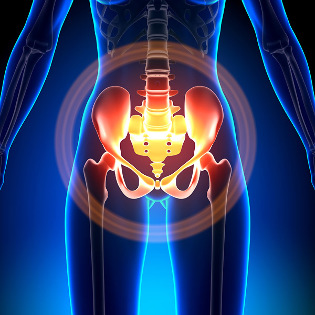Quite a frequent diagnosis in the medical practice has recently become varicose veins of the pelvis, and comes in both men and women. However, the statistic shows that the women face this problem more often than the opposite sex. Varices of the veins of the pelvis are prone to all age categories of women, but with the increase in the aged proportion is increasing, and the risk of developing this pathology. During the reproductive age of varicose veins of the vessels of the pelvis can be detected in 15-20% of women, while during the period of menopause are diagnosed in 75-80% of patients. In men the initial symptoms of varicose veins in the pelvic area most often occur in the period from 12 to 30 years.

ΑΙΤΊΕΣ ΕΜΦΆΝΙΣΗΣ OF VARICOSE VEINS OF THE PELVIS AND THE CHARACTERISTICS OF DEVELOPMENT WOMEN AND MEN
With the development of this disease promotes a specific number of reasons. Some of it depends on heredity and the general state of health, while others are the result of lifestyle and habits. Factors, predisposing to the appearance of varicose veins of the pelvis, is:
- pathological distension of the rectum and of the lower limbs;
- hereditary predisposition?
- inherent weakness of the connective tissue and venous walls is?
- the growth of tumors, tumors and hernias in the urinary system?
- pelvic inflammatory disease in chronic form?
- the sedentary way of life and static sports?
- heavy physical exercise?
- forced long lasting position sitting or standing?
- no regular sexual life?
- nervous disorders and frequent lack of sleep?
- poor diet and increased body weight?
- bad habits.
According to gender the above list is complemented by them or by other factors. For example, in men with this factor may be the feature of the structure of the blood vessels of the genital organs. This pathology bears the name of varicocele – the expansion of veins of the spermatic cord. Taking into account the characteristics of the male anatomy, we can say that often the disease is detected from the left side.
The characteristics of the development of varicose veins of the pelvis in women (the so-called female varicocele) is caused by the presence of the following risk factors:
- inflammatory gynecological diseases;
- mechanical compression of veins from the enlarged uterus?
- sexual disorders (discomfort during sexual intercourse and anorgasmia);
- abound and multiple pregnancy?
- many and heavy labor?
- change of a hormonal background
- hormonal therapy and contraception.
It is worth noting that, despite the high prevalence, varicose veins of the pelvis poorly studied, and there may be other causes for the appearance.
VARICOSE VEINS OF THE PELVIS, THE SYMPTOMS AND THE CHARACTERISTICS OF THE IN WOMEN AND MEN
Symptoms of varicose veins of the pelvis and in the early stages of the disease do not manifest themselves. Male patients has symptoms, which often can be detected only with the help of methods of palpation, ultrasound, functional tests and physical research. Only when the degree of destruction of the vein is particularly high, varicose veins can occur deformation of the penis and strong pain, even at rest.

In patients of both sexes suffering to varicose veins the veins of the pelvis are starting to been observed with the development of pathological changes in the blood vessels and worsening of outflow of blood. Localized is in the lower part of the abdomen, and have a different intensity, most patients are pain and pulling pain, giving at the sacrum-lumbar area. Happen or become more prominent, while walking, after long static and dynamic loads.
In phlebitis the veins of the pelvis in women symptoms brings you more intense character than in men:
- painful shocks in the lower part of the abdomen in the area of the perineum, and is reinforced, as a rule, after a long stay in an upright position or sit in? during the first few days of menstruation, after whiteness.
- unpleasant sensation in the genitals and the pelvis during sexual intercourse and some time after him?
- intense premenstrual syndrome?
- interruption of the menstrual cycle (dysmenorrhea): an increase in the duration and abundance of the menstrual period;
- increased secretion of the secretion of the external genital organs;
- venous nodules in the region of the perineum;
- particularly sensitive region of the perineum;
- impairment of urination.
HE HAS A PROBLEM WITH THE ΦΛΈΒΕΣ OF THE PELVIS DURING PREGNANCY
Pregnancy is a unique indication of the status of the health of the woman. Many diseases, running asymptomatic occur during the period of neo-nutrition of the fetus.
During pregnancy a rapid growing uterus takes up more and more space in the pelvis. At the end of the third quarter achieves the maximum possible size, and pushing one of the other bodies, pinch of venous vessels. Their walls, due to the reduction of the tone of the uterus, in this period is significantly weaker than usual. This physiological process is harmful to the health, and pregnancy can lead to rupture thrombosis, bleeding. And in the postpartum period anemia and painful sensations, leading to problems with the veins.
During the development of the fetal outflow of blood from the uterus increases to about 15-20 times, and valve welding vessels, the uterine cavity is not always with the manages. Violation occurs one-way ground voltage of the blood, causing venous congestion and inflammation. Blood circulation begins to become cycles during which use can the small blood vessels of the pelvic organs. This leads to the excess of blood, and, consequently, manifests itself has a problem with the veins of the pelvis. It is not excluded that after childbirth can occur and the reverse process, and the disease subsides.
Due to disorders of blood flow varicose veins of the pelvis leads to a lack of oxygen that enters the child. Develops hypoxia of the fetus, sometimes this is the reason for performing a caesarean section.
During pregnancy it is particularly important not to confuse has a problem with the veins of the uterus and of the pelvis. To define the exact disease will only help an investigation, based on methods with a high level of diagnostic capabilities: ultrasonography (ULTRASOUND), computed tomography (CT), magnetic resonance imaging (MRI). In this period of a woman's life preference is given to ULTRASOUND and MRI, because CT involves radiation exposure. The MRI is completely safe, but not recommended during the first trimester. Testimony for magnetic resonance imaging in varicose veins of the pelvis are the results of ULTRASOUND.
During pregnancy, the treatment of varicose veins of the pelvis using the methods only conservative treatment. Therefore, to completely rid of the disease will possible after the birth. In extremely critical situations resorting to surgery. Then, using minimally invasive modalities – radio frequency and laser technology coagulation.
In the treatment without surgery all of the recommendations refer mainly to the adaptation of one's lifestyle:
- to increase your physical activity. To carry out hiking at least two hours a day, with mandatory the ability to rest?
- to rule out lifting weights?
- you need to stick to a diet that includes foods rich in fiber (cereals, berries and fruits, vegetables) and high in good fats?
- a shower, a welcome visit to the pool?
- with the second quarter having to wear a specified kind of compression socks or prenatal bandage?
- to sleep on your side with a little pripodnatami feet?
- to exercise the respiratory and therapeutic exercise.
When there is an immediate threat of premature birth, the treatment is permanent, under constant the auspices of the medical staff.
THE TREATMENT OF VARICOSE VEINS OF THE PELVIS: APPLICATION OF DRUGS AND ΘΕΡΑΠΕΥΤΙΚΈΣ ΑΣΚΉΣΕΙΣ
In phlebitis the veins of the pelvis treatment consists of therapy, various medications, and special fitness exercises.
The use of drugs irreplaceable in the acute period of the disease. The main active ingredients are: diosmin, hesperidin, troxerutin, pentoxifylline. Vitamin complexes and tablets, containing fruit juices, extracts and vegetable oils as well as will give a moderate improvement of the situation of the patient.
Pregnant women, the doctors are trying to be granted within (varicose veins of the pelvis) solely on the basis of natural ingredients: extract of horse chestnut, green tea extract, vitamins, oils, etc. so the medications that have fewer side effects. Often the doctor for the treatment of gives a different direction for physical therapy or therapeutic exercise.
Gymnastic exercises in varicose veins of the pelvis have a wide range of action. It is the main type of treatment, which simultaneously has preventive value. Exercises require using back muscles, peritoneum, pelvis, and thigh, has a positive impact on the improvement tendency of the blood. Taking into account the intensity of possible loads, the characteristics of health status, of employment, at work and at home, you can get yourself a reasonable set of exercises.
Homework may include the next:
- the exercise "Bicycle": rotation of legs, lying on his back. 15-20 approaches?
- the exercise "Pulling up the knees: lift the chest, the knee, the setting of stocking up, fix it in this position for a few seconds. 10 approaches on each leg?
- the exercise "Scissors": in a supine position, keeping the hands along the torso, legs straight, stockings taut by yourself, with a series of crossed legs. 15 approaches?
- the exercise "Candle": the head, neck and shoulders are on the floor, the body must be fixed in an upright position with your back can not hold hands, to perform 5-7 minutes?
- exercise the flexibility of the back: the limb should be in the palm of your hand and your knees, fold first, then straighten your back. 10 approaches.
At work, for example, you can perform the following exercise:
- suggestion and straightening toes?
- circular rotation feet in a sitting position, 10 times?
- alternative transfer the weight of the body on one leg, then the other.
In the early stages of the disease complete the treatment of varicose veins of the pelvis can folk remedies. To them belongs the adoption of a tonic bubble bath, use of anti-inflammatory injections and contribute to the hematopoiesis broths.
The more money it is not difficult to prepare at home. Preference in the treatment of the disease is given: fruit and flowers of horse chestnut, birch chaga, dandelion roots, chamomile flowers.
Special place in treatment is prevention:
- the observance of a healthy lifestyle (quitting smoking and alcohol consumption);
- tropical general dining (lunch in small portions, 5 times a day at regular intervals);
- the optimal ratio of the load and the holidays?
- sexual life after of varicose veins of the pelvis will have to be mediocre?
- regular monitoring of the levels in the blood?
- visit phlebologist.
After recovering from the disease, the patient will mark the improvement not only of physical, but also emotional state.





































